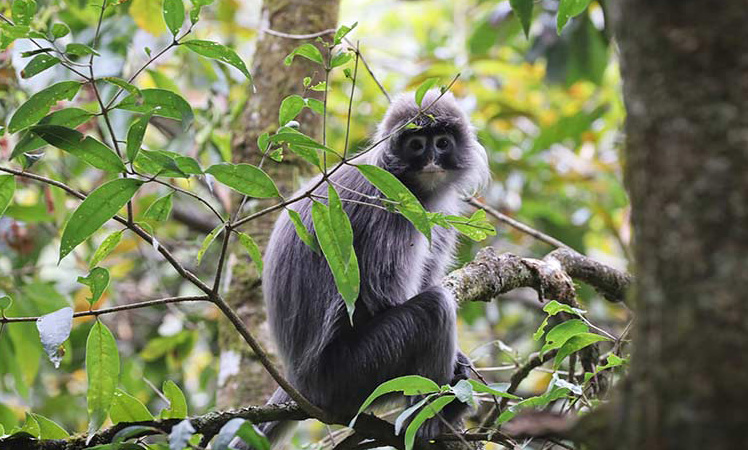China’s protection of giant pandas brings significant benefits to other species
China’s vigorous efforts to protect giant pandas, an endearing flagship species and umbrella species in nature conservations and also a popular national treasure of the country, have injected strong impetus to the protection of different ecosystems and the sustainable development of surrounding communities.

A giant panda plays at the Shenshuping base of the China Conservation and Research Center for the Giant Panda in Wolong National Nature Reserve, Wenchuan county, Aba Tibetan and Qiang autonomous prefecture, southwest China’s Sichuan province, Feb. 2, 2022. (People’s Daily Online/Chen Xianlin)
Over the past few decades, the habitats of wild animals in China have expanded and their populations have risen continuously.
In particular, the population of giant pandas in the wild has grown from 1,114 to 1,864 over the past four decades, and giant pandas have been downgraded from “endangered” to “vulnerable” on the list of species at risk of extinction, according to a white paper titled “Biodiversity Conservation in China” released by the country’s State Council Information Office.
The downgrading of giant panda’s conservation status has corroborated the upgrading of China’s ecological and environmental protection.
In recent years, China has established a total of 67 protected areas for giant pandas. The Giant Panda National Park under construction in the country covers an area of more than 27,000 square kilometers, including 88 percent of the population and 70 percent of the habitats of wild giant pandas in the country’s nature conservation network.
Giant pandas play an extremely important role in the course of nature conservation. Almost every habitat of giant pandas coincides with one of the most important distribution centers of species endemic to China.
Many of the species of birds, mammals, and amphibians endemic to China live in the habitats of giant pandas, which means that the country’s efforts to protect its umbrella species like giant panda can benefit other species distributed in the same areas.

Photo shows the picturesque scenery of Gengda township, Wenchuan county, Aba Tibetan and Qiang autonomous prefecture, southwest China’s Sichuan province. The ancient township is known for its folk culture and customs of the Tibetan ethnic group and natural habitat of giant pandas. (People’s Daily Online/Liu Guoxing)
The habitats of giant pandas are also the main habitats of wildlife species including golden monkeys and takins. In fact, a large variety of animal species can be seen in the habitats of giant pandas, such as coal tits and red-flanked bluetails, small migratory bird species that are not afraid of humans; blue eared pheasants that often chirp loudly at hillsides; and the Western Chinese mountain salamanders that inhabit mountain valleys.
Thanks to the establishment of protected areas for giant pandas, poaching incidents have been significantly reduced in the natural habitats of giant pandas. Therefore, wildlife populations have gradually recovered and ecosystems have been continuously restored.
The country’s protection of giant pandas has also driven economic and social development, achieving win-win results for giant panda conservation and improvement in people’s living standards.
Many people live in the long strip of land inhabited by giant pandas, which spans a large area starting from the Qinling Mountains in northwest China’s Shaanxi province, passing through Diebu county and Zhouqu county in northwest China’s Gansu province, and stretching into the Minshan Mountains, Qionglai Mountains, and Liangshan Yi autonomous prefecture in southwest China’s Sichuan province.
The lifestyle of local people has changed during the construction of the country’s nature conservation network for giant pandas. Many residents started to use energy-efficient cooking stove and renewable energy sources including methane, leading to a significant reduction in the number of trees cut for firewood. Meanwhile, some regions have explored ways to increase people’s income by facilitating the development of traditional Chinese medicinal herbs planting and beekeeping and selling green products to various cities.

Golden snub-nosed monkeys, companion animal of giant pandas, live a leisurely and comfortable life at the Hetaoping base of the China Conservation and Research Center for the Giant Panda in Wolong National Nature Reserve in southwest China’s Sichuan province, Oct. 4, 2021. (People’s Daily Online/He Shengshan)
It’s estimated that the value of ecosystem services provided by the habitats of giant pandas is 10 times that of the efforts and resources put into the protection of them.
The downgrading of conservation status doesn’t mean a reduction in the country’s efforts to protect wildlife. As it pushes ahead with the construction of its Giant Panda National Park, China will manage to shelter more wildlife species and help more living beings enjoy harmonious coexistence and thrive together by continuously enhancing endeavors to protect giant pandas.
Photos
Related Stories
- Infrared cameras capture wild giant pandas eating, playing in thick snow in Sichuan
- Survey of endangered gibbon species launched in southwest China
- Giant pandas, red pandas move into new houses at Chengdu's panda breeding facility
- Two new species discovered at Wuyishan National Park in SE China’s Fujian
- Efforts to preserve rare plant species in SW China's Gaoligong Mountain pay off
- Rare plant species rediscovered in southwest China after 83 years
- In pics: giant panda Jin Baobao at Ahtari zoo, Finland
- Twin giant panda cubs born in Madrid "fine, healthy"
- Washington national zoo celebrates panda cub Xiao Qi Ji's 1st birthday
- National parks can effectively alleviate isolation of wild giant panda population: research
Copyright © 2022 People's Daily Online. All Rights Reserved.










